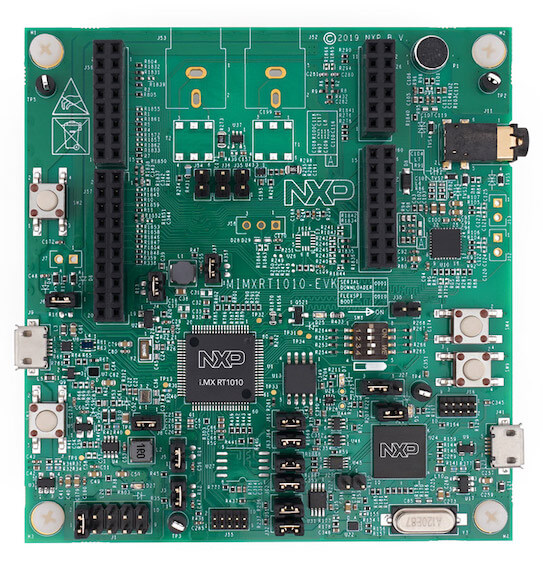NXP MIMXRT1010-EVK
Overview
The i.MX RT1010 offers a new entry-point into the i.MX RT crossover processor series by providing the lowest-cost LQFP package option, combined with the high performance and ease-of-use known throughout the entire i.MX RT series. This device is fully supported by NXP’s MCUXpresso Software and Tools.

Hardware
MIMXRT1011DAE5A MCU
Memory
128 Mbit QSPI Flash
Connectivity
Micro USB host and OTG connectors
Arduino interface
Audio
Audio Codec
4-pole audio headphone jack
External speaker connection
Microphone
Debug
JTAG 10-pin connector
OpenSDA with DAPLink
For more information about the MIMXRT1010 SoC and MIMXRT1010-EVK board, see these references:
Supported Features
The mimxrt1010_evk board configuration supports the following hardware features:
Interface |
Controller |
Driver/Component |
|---|---|---|
NVIC |
on-chip |
nested vector interrupt controller |
SYSTICK |
on-chip |
systick |
GPIO |
on-chip |
gpio |
SPI |
on-chip |
spi |
I2C |
on-chip |
i2c |
UART |
on-chip |
serial port-polling; serial port-interrupt |
USB |
on-chip |
USB device |
ADC |
on-chip |
adc |
GPT |
on-chip |
gpt |
The default configuration can be found in the defconfig file:
boards/arm/mimxrt1010_evk/mimxrt1010_evk_defconfig
Other hardware features are not currently supported by the port.
Connections and I/Os
The MIMXRT1010 SoC has five pairs of pinmux/gpio controllers.
Name |
Function |
Usage |
|---|---|---|
GPIO_11 |
GPIO |
LED |
GPIO_SD_05 |
GPIO |
SW4 |
GPIO_10 |
LPUART1_TX |
UART Console |
GPIO_09 |
LPUART1_RX |
UART Console |
GPIO_01 |
LPI2C1_SDA |
I2C SDA |
GPIO_02 |
LPI2C1_CLK |
I2C SCL |
GPIO_AD_03 |
LPSPI1_SDI |
SPI |
GPIO_AD_04 |
LPSPI1_SDO |
SPI |
GPIO_AD_05 |
LPSPI1_PCS0 |
SPI |
GPIO_AD_06 |
LPSPI1_SCK |
SPI |
GPIO_AD_01 |
ADC |
ADC1 Channel 1 |
GPIO_AD_02 |
ADC |
ADC1 Channel 2 |
System Clock
The MIMXRT1010 SoC is configured to use the 32 KHz low frequency oscillator on the board as a source for the GPT timer to generate a system clock.
Serial Port
The MIMXRT1010 SoC has four UARTs. LPUART1 is configured for the console,
and the remaining are not used.
Programming and Debugging
Build and flash applications as usual (see Building an Application and Run an Application for more details).
Configuring a Debug Probe
A debug probe is used for both flashing and debugging the board. This board is configured by default to use the OpenSDA DAPLink Onboard Debug Probe, however the pyOCD Debug Host Tools do not yet support programming the external flashes on this board so you must reconfigure the board for one of the following debug probes instead.
J-Link External Debug Probe
Install the J-Link Debug Host Tools and make sure they are in your search path.
Attach a J-Link 10-pin connector to J55. Check that jumpers J61 and J62 are off (they are on by default when boards ship from the factory) to ensure SWD signals are disconnected from the OpenSDA microcontroller.
Configuring a Console
Regardless of your choice in debug probe, we will use the OpenSDA microcontroller as a usb-to-serial adapter for the serial console. Check that jumpers J31 and J32 are on (they are on by default when boards ship from the factory) to connect UART signals to the OpenSDA microcontroller.
Connect a USB cable from your PC to J41.
Use the following settings with your serial terminal of choice (minicom, putty, etc.):
Speed: 115200
Data: 8 bits
Parity: None
Stop bits: 1
Flashing
Here is an example for the Hello World application.
# From the root of the zephyr repository
west build -b mimxrt1010_evk samples/hello_world
west flash
Open a serial terminal, reset the board (press the SW9 button), and you should see the following message in the terminal:
Hello World! mimxrt1010_evk
